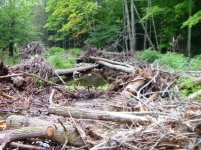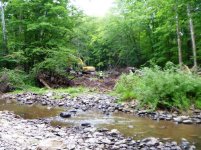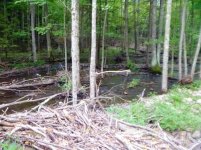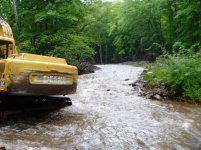Rusty Spinner
Well-known member
Our Fred Burroughs North Jersey TU chapter completed a log jam removal in the Big Flat Brook River on Monday (23rd). This was done under a DEP permit-by-rule secured by the NJ Division of F&W for us. The jam was caused during Hurricane Irene last August. Yes, it was a natural occurring event which brought much discussion as to whether or not to leave it alone or remove it. In the end, it was agreed by all that it would take decades to form a new channel and in the meantime, trout habitat would greatly suffer from the jam (between Werner's Hole on the Big Flat and the Blewett Tract where the Big and Little Flat Brook meet to form the Flat Brook River). So we removed it to restore flows and keep beavers from damming it and flooding the valley, potentially wiping out a Federally endangered species of mussels.
Here are some pix...






The 1st picture show a part of this 200 yard long mass of trees jamming the channel and forcing about 1/2 of the flows at low water to fan out into the surrounding forest into numerous shallow channels that brought lots of fresh sediment into the river well downstream. Photo 2 shows the track machine about half way up the jam after removing much of the larger trees. We would come back downstream moving more trees and widening the channel only to the extent to allow the river to flow freely once again. The 3rd shot is the new channels in the forest where the Division electro fished late last week to remove fish trapped in them (wild brookies and some wild browns plus various baitfish). Picture 4 is the machine working on removal. The big, nasty common snapping turtle was rescued out of harm's way by a turtle expert sent by the Division to rescue any wood turtles which we did not find. The lost shot is the newly restored flows. Look at picture # 2 to see how low the flows were in that same spot earlier that day. We could not do any habitat enhancement under this permit, so the riffle is currently too steep and will eventually head cut its way upstream into a deeper pool and find its own equilibrium in time. The chapter paid for this project using Green Hills Excavating out of Byram, someone I use for boulder deliveries for river channel restoration projects on the Musky and other rivers. They did a great job in spite of us getting hammered for over an hour by nasty t-storms, heavy rains and pelting hail.
Here are some pix...






The 1st picture show a part of this 200 yard long mass of trees jamming the channel and forcing about 1/2 of the flows at low water to fan out into the surrounding forest into numerous shallow channels that brought lots of fresh sediment into the river well downstream. Photo 2 shows the track machine about half way up the jam after removing much of the larger trees. We would come back downstream moving more trees and widening the channel only to the extent to allow the river to flow freely once again. The 3rd shot is the new channels in the forest where the Division electro fished late last week to remove fish trapped in them (wild brookies and some wild browns plus various baitfish). Picture 4 is the machine working on removal. The big, nasty common snapping turtle was rescued out of harm's way by a turtle expert sent by the Division to rescue any wood turtles which we did not find. The lost shot is the newly restored flows. Look at picture # 2 to see how low the flows were in that same spot earlier that day. We could not do any habitat enhancement under this permit, so the riffle is currently too steep and will eventually head cut its way upstream into a deeper pool and find its own equilibrium in time. The chapter paid for this project using Green Hills Excavating out of Byram, someone I use for boulder deliveries for river channel restoration projects on the Musky and other rivers. They did a great job in spite of us getting hammered for over an hour by nasty t-storms, heavy rains and pelting hail.
